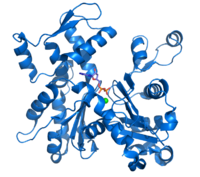
Photo from wikipedia
The motuporamines are a promising class of anti-metastatic compounds. Dihydromotuporamine C (Motu33) has been shown to activate the small GTPase RhoA, however, little is known about subsequent downstream events leading… Click to show full abstract
The motuporamines are a promising class of anti-metastatic compounds. Dihydromotuporamine C (Motu33) has been shown to activate the small GTPase RhoA, however, little is known about subsequent downstream events leading to cell migration inhibition. In the present study, we investigated the mechanism of action of Motu33 and a synthetic derivative, Motu-(CH2)-33, in Drosophila by manipulating the gene dose of positive and negative regulators of actin dynamics. Consistent with previous findings, reduced gene dose of Rho1 (the Drosophila RhoA ortholog) attenuates motuporamine activity, confirming that RhoA/Rho1 is targeted by these compounds. Actin-myosin contraction is controlled by the RhoA-ROCK-myosin regulatory light chain (MRLC) pathway. Reduced gene dose of the myosin binding subunit of myosin phosphatase, a negative regulator of the RhoA-ROCK-MRLC pathway, enhances motuporamine activity indicating that the motuporamines stimulate actin-myosin contraction through activation of the myosin regulatory light chain. RhoA also activates diaphanous (dia) to control actin polymerization. Surprisingly, reduced gene dose of dia enhances motuporamine activity, suggesting that the motuporamines act on dia in a RhoA-independent manner. Reduction in gene dose of the Drosophila Rac orthologs also enhances motuporamine activity. In contrast, motuporamine activity is unaltered by reduced gene dose of slingshot (ssh) which acts to trigger actin severing and depolymerization. Since ssh is directly regulated by Rac, the enhanced activity of motuporamines observed when Rac gene dose is reduced may reflect an indirect mode of action on the Rac GTPases leading to increased RhoA activity. In summary, these findings demonstrate that motuporamines act through RhoA and diaphanous to regulate actin-myosin contractility and actin polymerization. Citation Format: Laurence von Kalm, Corey Seavey. The cell migration inhibitor dihydromotuporamine C regulates actin-myosin contractility and actin polymerization [abstract]. In: Proceedings of the American Association for Cancer Research Annual Meeting 2023; Part 1 (Regular and Invited Abstracts); 2023 Apr 14-19; Orlando, FL. Philadelphia (PA): AACR; Cancer Res 2023;83(7_Suppl):Abstract nr 2461.
Journal Title: Cancer Research
Year Published: 2023
Link to full text (if available)
Share on Social Media: Sign Up to like & get
recommendations!